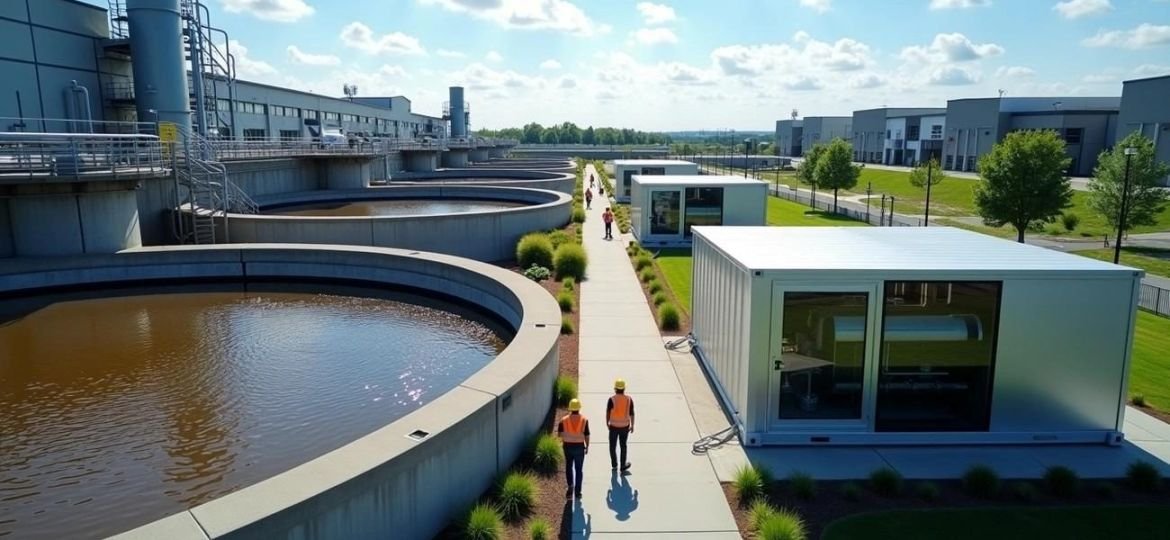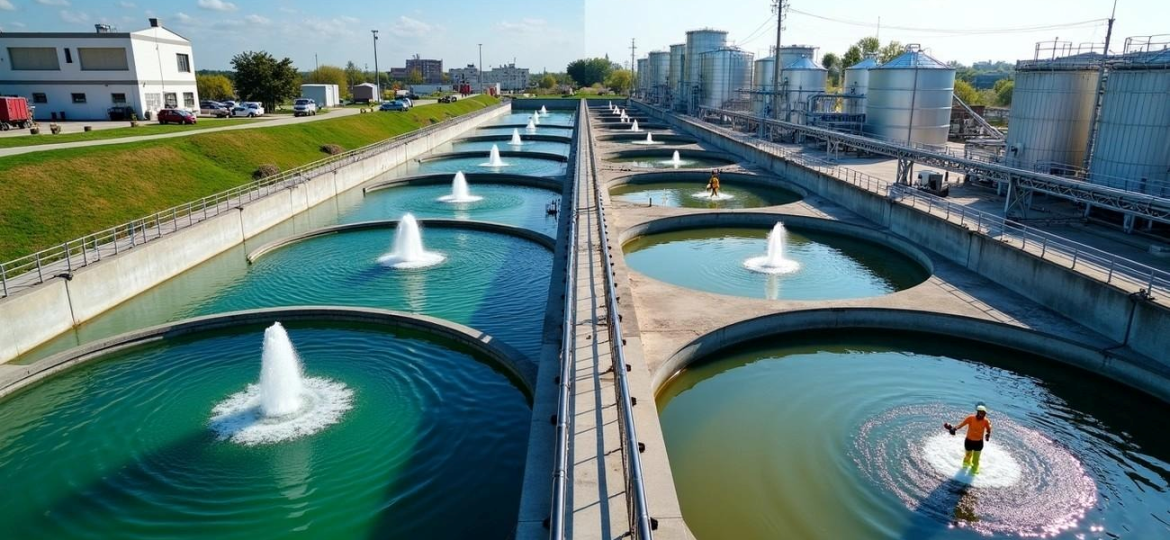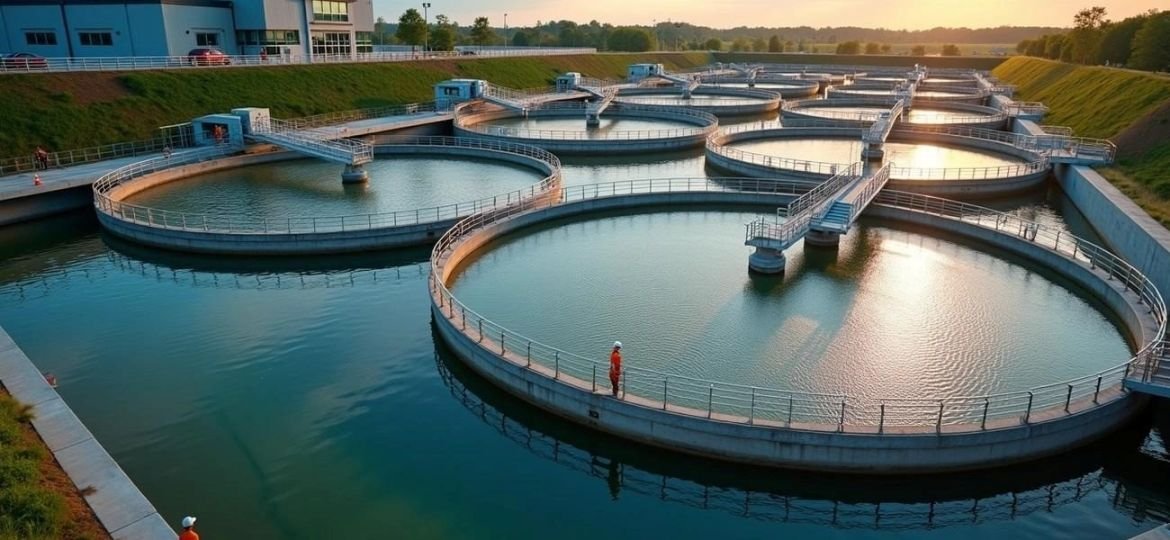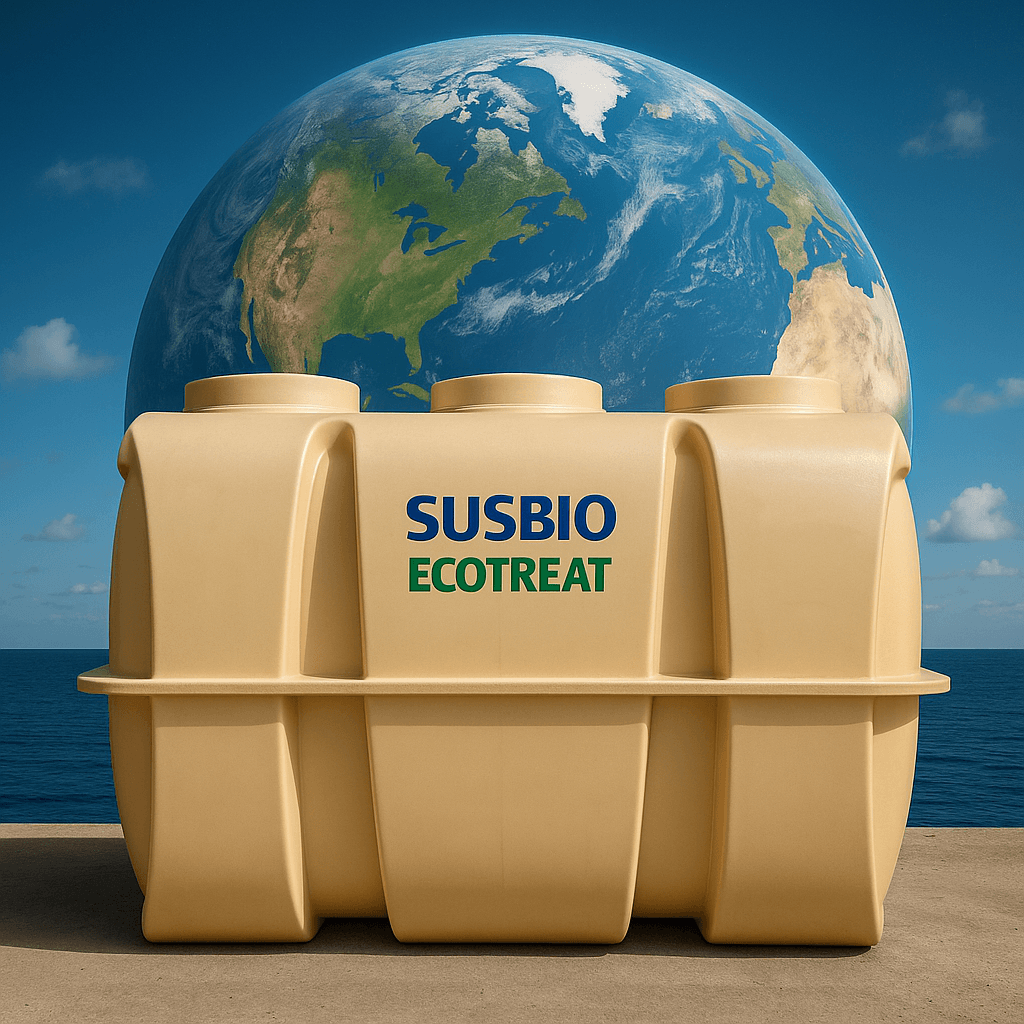Domestic wastewater poses a challenge but also presents a chance to better manage our planet’s water resources. UNESCO data shows that high-income countries treat about 74% of their sewage. Developing countries can only manage 4.2% on average. This gap shows how much we need working treatment systems worldwide.
The world currently treats 52% of its sewage. This number must grow substantially to meet the rising need for clean water. Proper wastewater treatment helps maintain water quality and protects public health. A domestic wastewater treatment plant processes household sewage and makes it safe to release back into the environment.
Treatment happens in several stages. The first stage removes 40-60% of suspended solids. Secondary treatment uses biological processes like activated sludge that break down organic matter. The United Nations’ 2017 World Water Development Report suggests that wastewater could be a vital resource. It can help meet our growing need for freshwater and raw materials.
This piece will take you through the complete sewage treatment experience. You’ll learn what makes up domestic sewage and discover advanced treatment technologies. The content covers processing stages, sludge management methods, and ways to safely discharge or reuse treated water.
Understanding Domestic Wastewater and Its Sources
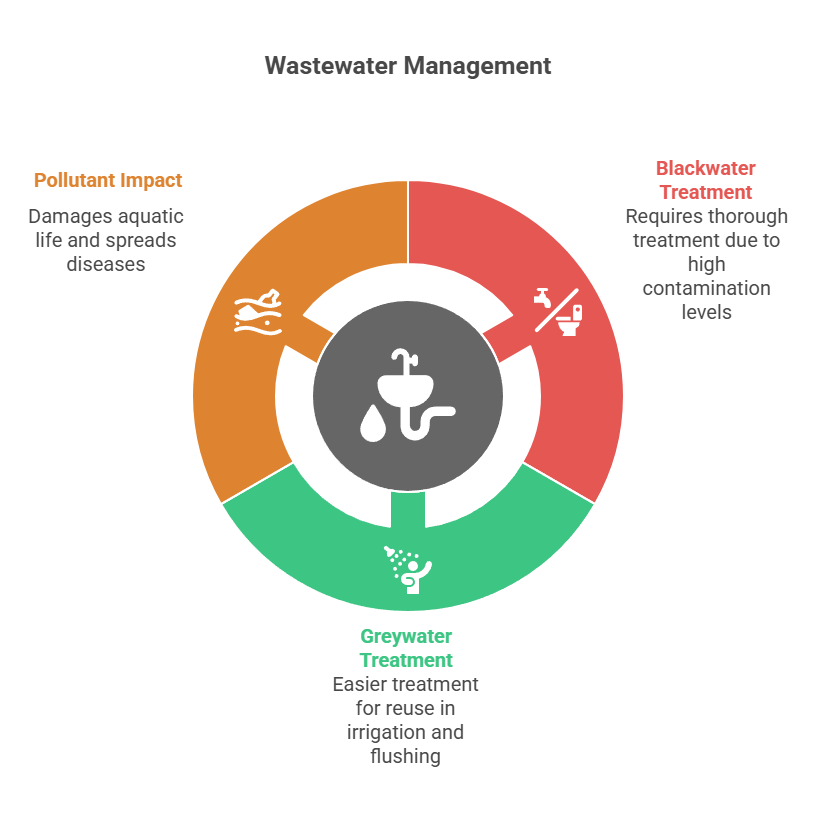
Households create large amounts of used water that needs proper treatment each day. People’s daily activities like bathing, washing dishes, and flushing toilets generate what experts call sanitary sewage. This used water has pollutants that harm human health and the environment without proper treatment.
Domestic sewage meaning and classification
Sewers carry liquid and solid wastes that we call domestic sewage. Water makes up most of it (99.9%), while solids – both dissolved and suspended – account for just 0.1%. These solids combine organic matter, inorganic substances, and microorganisms. The sewage splits into two categories: domestic and industrial. Household wastes mixed with human and animal excreta make up domestic sewage.
Greywater vs blackwater: Key differences
Home wastewater falls into two distinct groups based on how contaminated it is:
Blackwater comes from toilets and contains fecal matter and urine. Kitchen wastewater from dishwashers belongs to this category because it has pathogens and grease. This type needs more thorough treatment since it carries bacteria and viruses that cause diseases. Some people call it sewage or brown water.
Greywater flows from sinks, washing machines, bathtubs, and showers. The contamination levels are lower, which makes treatment easier. A family of four creates about 360 liters of greywater each day – that’s 40% of their total wastewater. With proper treatment, people can reuse greywater for irrigation, constructed wetlands, toilet flushing, and washing.
Common pollutants in household wastewater
Domestic wastewater contains several pollutants:
- Organic matter (about 52% of wastewater content), including proteins (40%), carbohydrates (25-50%), and oils and grease (10%)
- Inorganic matter (about 48%) including nitrogen and phosphorus compounds
- Nutrients like nitrogen and phosphorus that cause eutrophication
- Detergents, household chemicals, and personal care products
- Pathogens (bacteria, viruses, protozoa, and helminths)
- Microplastics, sediments, and other pollutants
These pollutants raise biological oxygen demand (BOD) and chemical oxygen demand (COD) levels. They can change water pH, hardness, and pathogen load. Untreated domestic wastewater damages aquatic life, reduces crop yields, and spreads waterborne diseases.
Step-by-Step Breakdown of the Wastewater Treatment Process
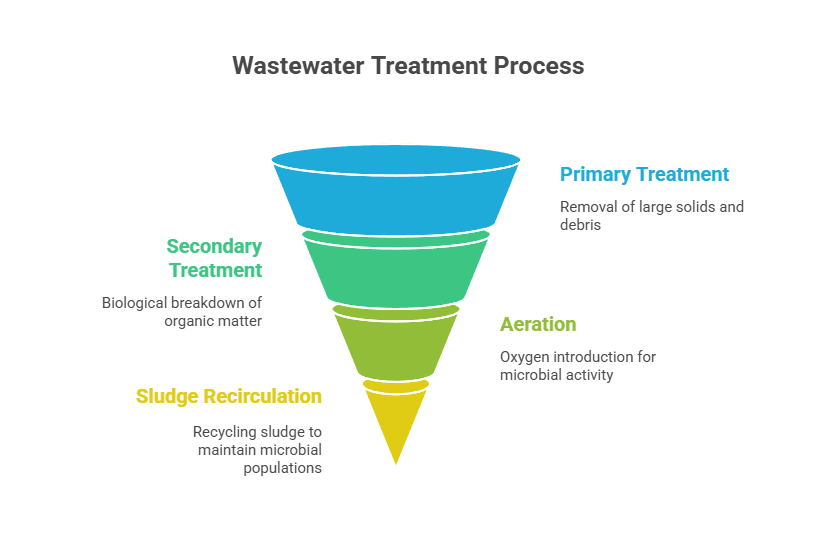
Wastewater treatment changes contaminated domestic sewage into environmentally safe water through several well-designed stages. Each stage removes specific contaminants from the water in a systematic way.
Preliminary treatment: Screening and grit removal
The treatment begins when wastewater reaches the preliminary stage where workers remove large objects. Bar screens with openings from 0.5 to 4 inches catch materials like rags, plastics, and debris that could harm equipment downstream. Modern facilities use mechanically cleaned screens that work at approach velocities of 3.0 feet per second or less during peak flows. The next step involves grit chambers that collect heavier inorganic materials such as sand, gravel, and small stones. Aerated grit chambers add oxygen early and typically run with detention times of 3 minutes during maximum flow rates.
Primary treatment: Sedimentation and flow equalization
Primary sedimentation tanks let suspended solids settle naturally. This method removes 50-65% of suspended solids and 30-40% of the biological oxygen demand (BOD) from sewage. Flow equalization basins work with sedimentation to store and balance incoming wastewater. These basins alleviate changes in flow rate and pollutant concentration. Proper aeration keeps solids suspended and prevents septicity while reducing odor formation in these basins.
Secondary treatment: Activated sludge and trickling filters
Secondary treatment uses biological processes to remove dissolved and suspended organic matter. Microorganisms in aeration tanks consume organic pollutants through a managed aerobic process called activated sludge systems. Trickling filters work differently as non-submerged fixed-bed biological reactors where microorganisms create biofilm on media surfaces. The combination of these processes can cut energy needs by 25-50% compared to activated sludge alone.
Tertiary treatment: UV disinfection and nutrient removal
Advanced methods purify water in the final stage. UV disinfection kills microorganisms by destroying their genetic structures. Special technologies remove excess nitrogen and phosphorus that might cause eutrophication. Some facilities need the highest quality standards and add quaternary treatment to eliminate micropollutants like pharmaceuticals through advanced oxidation processes.
Sludge Management and By-product Handling
Sludge management plays a vital role in domestic wastewater treatment cycles. Treatment plant’s operating costs typically range between 45-65% for this crucial process. Specialized handling becomes necessary for the residual material that builds up during treatment before its final disposal or reuse.
Sludge thickening and dewatering methods
The initial step in sludge treatment focuses on thickening, which makes handling more practical by reducing volume. Gravity thickeners can cut total sludge volume in half. Air bubbles in dissolved-air flotation carry solids to the surface, while rotary-drum thickeners mix sludge to lower water content. The process continues with dewatering, which further reduces volume through centrifugation, belt filter presses, or sludge-drying beds. These methods can achieve up to 40% solids content effectively.
Anaerobic vs aerobic digestion of sludge
The breakdown of organic matter happens without oxygen in anaerobic digestion, creating valuable methane-rich biogas for renewable energy. This method produces minimal sludge that becomes fully stabilized for disposal. Aerobic digestion requires oxygen and improves biodegradable waste quality, but needs energy input instead of producing it. Most facilities combine both approaches to optimize treatment efficiency.
Reuse of treated sludge in agriculture
Treated sludge’s nutrient content includes 3.4-4% nitrogen and 0.5-2.5% phosphorus, making it a valuable agricultural fertilizer and soil enhancer. Crop yields increase significantly when farmers combine sewage sludge with inorganic fertilizers. All the same, proper treatment must reduce pathogens and heavy metals before any agricultural use.
Reuse, Discharge, and Environmental Compliance

Treated domestic wastewater becomes a valuable resource instead of waste. The way we handle treated effluent requires careful balance between protecting the environment and finding useful ways to reuse it.
Effluent quality standards for discharge
Natural water bodies can only receive treated wastewater that meets strict regulatory standards. The Clean Water Act requires an NPDES permit to discharge any pollutants. These permits set specific limits for several key parameters:
- Biochemical Oxygen Demand (BOD): The level should not exceed 30 mg/L
- Total Suspended Solids (TSS): Surface water inland needs levels below 100 mg/L
- pH: The range should stay between 5.5-9.0
Water reuse in irrigation and non-potable applications
Treated wastewater provides a sustainable alternative water source. Agriculture uses 72% of global freshwater resources, which makes irrigation the most common reuse application. Israel stands out as a global leader by reusing 90% of its reclaimed water in agricultural irrigation. The water finds its way into various applications:
- Parks and golf courses need landscape irrigation
- Factories and refineries use it for industrial processes
- Buildings can use it for non-drinking purposes like toilet flushing
Role of domestic wastewater treatment in SDG 6
Safe treatment happens for about 56% of domestic wastewater worldwide. This number shows we still have work to do to reach Sustainable Development Goal 6. Good wastewater management helps achieve at least 11 of the 17 SDGs. The benefits include better water availability, improved public health, and less environmental pollution.
Frequently Asked Questions
1. What is domestic wastewater and why is its treatment important?
Domestic wastewater is water from households, including greywater and blackwater, generated through bathing, cooking, washing, and flushing. Treating it is crucial to protect public health, maintain water quality, and prevent environmental pollution.
2. What are the main stages in domestic wastewater treatment?
The treatment process involves several steps:
Preliminary treatment: Screening and grit removal
Primary treatment: Sedimentation and flow equalization
Secondary treatment: Biological processes like activated sludge or trickling filters
Tertiary treatment: Advanced disinfection and nutrient removal
3. What is the difference between greywater and blackwater?
Greywater comes from sinks, showers, and washing machines and is less contaminated. Blackwater includes toilet waste and kitchen wastewater containing fecal matter and pathogens, requiring more intensive treatment.
4. How is sludge managed in domestic wastewater treatment plants?
Sludge is treated through thickening, dewatering, and digestion (aerobic or anaerobic). Anaerobic digestion also produces biogas, while treated sludge can be reused as fertilizer after removing pathogens and heavy metals.
5. Can treated domestic wastewater be reused? If yes, how?
Yes. Treated domestic wastewater can be reused for irrigation, landscaping, toilet flushing, industrial cooling, and other non-potable purposes. Proper treatment ensures safety and compliance with environmental regulations.
Conclusion
Domestic wastewater treatment plays a vital role in protecting our environment and public health. This piece explores the complex steps wastewater takes from household drains until it’s safe to discharge or reuse. Modern engineering tackles different pollutants through multiple treatment stages. These stages include preliminary screening, primary sedimentation, secondary biological processes, and advanced tertiary methods.
Understanding the difference between greywater and blackwater helps determine the right treatment needs. Proper sludge management turns waste into a resource for agriculture through thickening, dewatering, and digestion processes.
Treated wastewater has become a precious resource in our water-scarce world. The change from waste to resource matches perfectly with Sustainable Development Goal 6. However, a big gap exists between high-income and developing nations’ treatment capabilities.
Advanced technology hasn’t solved everything. About 44% of domestic wastewater worldwide still doesn’t get proper treatment. This shows how badly developing regions need infrastructure investment and technology transfer.
The future of wastewater treatment facilities will focus on energy-efficient processes, nutrient recovery systems, and more water reuse applications. Water security strategies worldwide will without doubt rely more on domestic wastewater treatment as populations grow and freshwater resources face increasing pressure.



